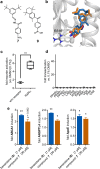Scaffold-Hopping from Synthetic Drugs by Holistic Molecular Representation
- PMID: 30405170
- PMCID: PMC6220272
- DOI: 10.1038/s41598-018-34677-0
Scaffold-Hopping from Synthetic Drugs by Holistic Molecular Representation
Abstract
The discovery of novel ligand chemotypes allows to explore uncharted regions in chemical space, thereby potentially improving synthetic accessibility, potency, and the drug-likeness of molecules. Here, we demonstrate the scaffold-hopping ability of the new Weighted Holistic Atom Localization and Entity Shape (WHALES) molecular descriptors compared to seven state-of-the-art molecular representations on 30,000 compounds and 182 biological targets. In a prospective application, we apply WHALES to the discovery of novel retinoid X receptor (RXR) modulators. WHALES descriptors identified four agonists with innovative molecular scaffolds, populating uncharted regions of the chemical space. One of the agonists, possessing a rare non-acidic chemotype, revealed high selectivity on 12 nuclear receptors and comparable efficacy as bexarotene on induction of ATP-binding cassette transporter A1, angiopoietin like protein 4 and apolipoprotein E. The outcome of this research supports WHALES as an innovative tool to explore novel regions of the chemical space and to detect novel bioactive chemotypes by straightforward similarity searching.
Conflict of interest statement
G.S. declares a potential financial conflict of interest in his role as life science industry consultant and cofounder of inSili.com GmbH, Zurich.
Figures





Similar articles
-
Molecular Scaffold Hopping via Holistic Molecular Representation.Methods Mol Biol. 2021;2266:11-35. doi: 10.1007/978-1-0716-1209-5_2. Methods Mol Biol. 2021. PMID: 33759119
-
Natural products used as a chemical library for protein-protein interaction targeted drug discovery.J Mol Graph Model. 2018 Jan;79:46-58. doi: 10.1016/j.jmgm.2017.10.015. Epub 2017 Oct 27. J Mol Graph Model. 2018. PMID: 29136547
-
Forging New Scaffolds from Old: Combining Scaffold Hopping and Hierarchical Virtual Screening for Identifying Novel Bcl-2 Inhibitors.Curr Top Med Chem. 2019;19(13):1162-1172. doi: 10.2174/1568026619666190618142432. Curr Top Med Chem. 2019. PMID: 31210110
-
Charting, navigating, and populating natural product chemical space for drug discovery.J Med Chem. 2012 Jul 12;55(13):5989-6001. doi: 10.1021/jm300288g. Epub 2012 May 11. J Med Chem. 2012. PMID: 22537178 Review.
-
Approaching Pharmacological Space: Events and Components.Methods Mol Biol. 2018;1800:245-274. doi: 10.1007/978-1-4939-7899-1_12. Methods Mol Biol. 2018. PMID: 29934897 Review.
Cited by
-
Evaluation of different virtual screening strategies on the basis of compound sets with characteristic core distributions and dissimilarity relationships.J Comput Aided Mol Des. 2019 Aug;33(8):729-743. doi: 10.1007/s10822-019-00218-8. Epub 2019 Aug 21. J Comput Aided Mol Des. 2019. PMID: 31435894
-
De Novo Molecular Design with Chemical Language Models.Methods Mol Biol. 2022;2390:207-232. doi: 10.1007/978-1-0716-1787-8_9. Methods Mol Biol. 2022. PMID: 34731471
-
Visualization of Topological Pharmacophore Space with Graph Edit Distance.ACS Omega. 2022 Apr 12;7(16):14057-14068. doi: 10.1021/acsomega.2c00173. eCollection 2022 Apr 26. ACS Omega. 2022. PMID: 35559135 Free PMC article.
-
Exposing the Limitations of Molecular Machine Learning with Activity Cliffs.J Chem Inf Model. 2022 Dec 12;62(23):5938-5951. doi: 10.1021/acs.jcim.2c01073. Epub 2022 Dec 1. J Chem Inf Model. 2022. PMID: 36456532 Free PMC article.
-
Prediction of Dielectric Constant in Series of Polymers by Quantitative Structure-Property Relationship (QSPR).Polymers (Basel). 2024 Sep 26;16(19):2731. doi: 10.3390/polym16192731. Polymers (Basel). 2024. PMID: 39408442 Free PMC article.
References
-
- Schneider G, Schneider P, Renner S. Scaffold-hopping: how far can you jump? Mol. Inf. 2006;25:1162–1171.
-
- Todeschini, R. & Consonni, V. Molecular Descriptors for Chemoinformatics41 (Wiley VCH, 2009).
Publication types
MeSH terms
Substances
LinkOut - more resources
Full Text Sources

